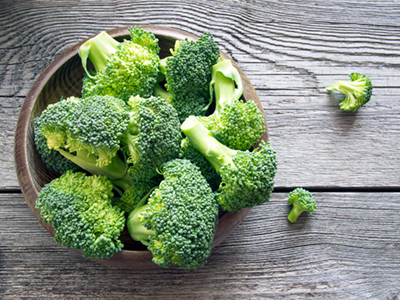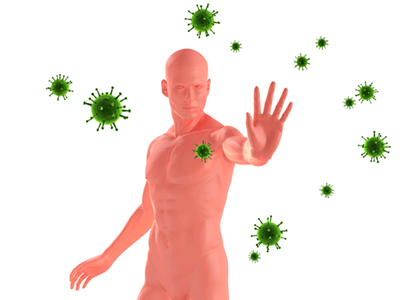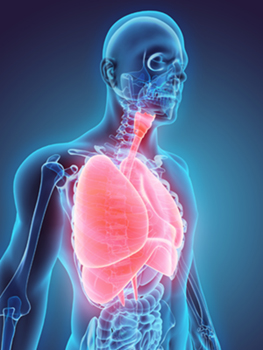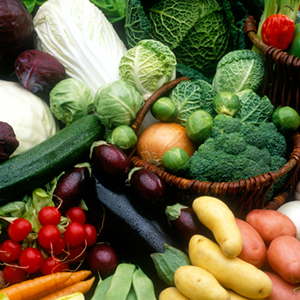
 Ingredients from broccoli and related vegetables inhibit cancer growth and intensify chemotherapies’ effects. Sulforaphane, a phytochemical available primarily in cruciferous plants, shows immune-strengthening effects, is used therapeutically as well as preventatively and has evidently antioxidative and cell protecting properties. Latest research results prove that the active substance even is able to reduce social and communicative problems in autism. In combination with cress, the included enzyme myrosinase synergetically intensifies the effectiveness of sulforaphane – this means highly concentrated bioavailability for an optimal gentle immune and cell protection.
Ingredients from broccoli and related vegetables inhibit cancer growth and intensify chemotherapies’ effects. Sulforaphane, a phytochemical available primarily in cruciferous plants, shows immune-strengthening effects, is used therapeutically as well as preventatively and has evidently antioxidative and cell protecting properties. Latest research results prove that the active substance even is able to reduce social and communicative problems in autism. In combination with cress, the included enzyme myrosinase synergetically intensifies the effectiveness of sulforaphane – this means highly concentrated bioavailability for an optimal gentle immune and cell protection.
Since antiquity, cruciferous plants (Brassicaceae) are well known for their healing effects. In traditional medicine, they are internally used against infection and inflammation, external applications i.e. as a mustard plaster are used against pain, muscle cramps, abscess, and for desinfection and wound healing. Glucosinolates occur as secondary metabolites of almost all plants of the order Brassicales (e.g. families Brassicaceae = Cruciferae, Capparidaceae, and Caricaceae), but also in the genus Drypetes (family Euphorbiaceae). For example, glucosinolates occur in cabbages (white cabbage, Chinese cabbage, broccoli), watercress, horseradish, capers and radishes. They are typically in parts consumed, with the typically pungent (hot or bitter) taste of these vegetables due to breakdown products (isothiocyanates or mustard oils) of glucosinolates. The glucosinolates are also found in the seeds of these plants. The pungency of those plants is due to mustard oils produced from glucosinolates when the plant material is chewed, cut, or otherwise damaged. These natural chemicals most likely contribute to plant defense against pests and diseases, but are also enjoyed in small amounts by humans and are believed to contribute to the health promoting properties of cruciferous vegetables. Glucosinolates, first isolated and described 1992 by Paul Talalay and his colleagues at the Johns Hopkins University, Baltimore, act as strong indirect antioxidants. Until today, more than 150 different glucosinolates in diverse plant families were isolated. Concentration varies and is responsible for the vegetable’s hot (radish) or bitter taste (cabbage). Glucoraphanin is one of the best known and most examined glucosinolates. When foods with glucoraphanin are consumed, the enzyme myrosinase transforms glucoraphanin into raphanin, which is an antibiotic, and into sulforaphane, which exhibits anti-cancer and antimicrobial properties in experimental studies.
Sulphoraphane: italian power from broccoli
Plants producing large amounts of glucosinolates are under basic research for potential actions against cancer, with the hydrolysis product of the glucoraphanin (the primary glucosinolate in broccoli), sulforaphane, being the best known example. Most recently, a randomized controlled study evaluating the effects of broccoli seed supplementation on autism spectrum disorder is underway. The makeup of glucosinolates and their hydrolysis products varies by vegetable. The highest amount of sulphoraphane by far is reported in broccoli (Brassica oleracea var. italica Plenck), which originally has been cultivated in Asia Minor. In the 16th century, Caterina de’ Medici brought the plant (ital. "broccolo") to France, from there, the so-called ‘italian asparagus’ was sent to England. In the 18th century, the US American president Thomas Jefferson at first brought it as an experimental plant to the USA. Until today, the main areas of cultivation are in Italy near Verona, because of the region’s optimal climate conditions inevitably for a not hardy cabbage vegetable like broccoli. Caused by George Bush senior’s sensational cry “I hate broccoli!” the cabbage even achieves worldwide fame.
Broccoli – healthy energy from A to Z Broccoli is particularly rich in minerals like potassium, calcium, phosphor, iron, zinc, and sodium as well as vitamins like B1, B2, B6, E, especially ascorbic acid (vitamin C), and carotene (provitamin A). It also contains numerous phytochemicals, i.e., flavonoids and glucosinolates as well as plant pigments like chlorophyll, zeaxanthin and lutein. The glucosinolates are also containing several indoles and numerous isothiocyanates. Apart from sulforaphane, broccoli also contains the isothiocyanates 3-methylsulfinylpropylisothiocyanate, 3-butenylisothiocyanate, allylisothiocyanate and 4-methylsulfinylbutylisothiocyanate. Like cauliflower, the flowerets of broccoli are the not fully developed inflorescences while the buds are clearly evident. The head is mostly colored deep green to blue-green, while violet, yellow or white varieties are rare. As soon as the central flower is well developed but still closed, they are harvested. The axillary buds and further flower heads can also be harvested later on. The broccoli ‘flower’ can be used exclusively or completely with its strong stems.
Broccoli is particularly rich in minerals like potassium, calcium, phosphor, iron, zinc, and sodium as well as vitamins like B1, B2, B6, E, especially ascorbic acid (vitamin C), and carotene (provitamin A). It also contains numerous phytochemicals, i.e., flavonoids and glucosinolates as well as plant pigments like chlorophyll, zeaxanthin and lutein. The glucosinolates are also containing several indoles and numerous isothiocyanates. Apart from sulforaphane, broccoli also contains the isothiocyanates 3-methylsulfinylpropylisothiocyanate, 3-butenylisothiocyanate, allylisothiocyanate and 4-methylsulfinylbutylisothiocyanate. Like cauliflower, the flowerets of broccoli are the not fully developed inflorescences while the buds are clearly evident. The head is mostly colored deep green to blue-green, while violet, yellow or white varieties are rare. As soon as the central flower is well developed but still closed, they are harvested. The axillary buds and further flower heads can also be harvested later on. The broccoli ‘flower’ can be used exclusively or completely with its strong stems.
Strategic DNA protection - highly active & sustainable from broccoli
In broccoli, sulforaphane is available as sulforaphane glucosinolate (mustard oil glucoside glucoraphane) and in the intestine is metabolized to the isothiocyanate sulforaphane, a highly active antioxidant. Sulforaphane neutralizes free radicals not directly, but indirectly by activating detoxifying enzymes of the phase-II-metabolism. This is the main difference to vitamin C, E or β-carotine, which pass away when fighting against free radicals, while sulforaphane activates endogenous detoxifying enzymes in the liver which, for their part, neutralize cancerogenic free radicals. So sulforaphane has an indirect effect without being used up itself and therefore four to five days offers active cell protection. Consequently, antioxidant defense mechanisms can be started and the DNA can be protected on a long-term basis.
Sulforaphane & quercetin – bioactivity against tumor growth & metastasis Current studies of the ‘Universitätsklinikum Heidelberg’ and the ‘Deutsches Krebsforschungszentrum’ have shown that sulforaphane from broccoli and similar vegetables can stop tumor growth in pancreatic cancer. The medical researcher Ingrid Herr, who has been awarded with the ‘Sebastian-Kneipp-Preis’, was able to prove that sulforaphane also has an intensifying effect on chemotherapies. The phytochemical’s antitumor effect is based on the inhibition of the so-called NF-kappa B signaling pathway, which is used by the particularly aggressive stem cells of the pancreatic cancer to protect themselves against chemotherapies’ harmful effects. The natural, powerful sulforaphane intervenes and stops this cellular self-protection and bioactive suppresses their resistance to chemotherapies. Results of a Canadian nutritional study are supporting these data of the Heidelberg researchers: In a group of patients with prostate cancer weekly eating broccoli or cauliflower, the metastasis could be reduced by 50%. The protective effect is completed by ‘quercetin’, which is available in broccoli as well as in onions, apple peel and a greater number of further fruit and vegetables. The yellow flavonol has been promoted for its extensive positive physiological effects as well as prevention and treatment of cancer, which is based on its antioxidant potential. Like the vitamins A, C and E, quercetin is a radical scavenger; the exact process of oxidation-inhibition in-vivo is still discussed. Current study results verify the direct anti-carcinogenic effect of quercetin by stopping further tumor growth and finally leading them to death.
Current studies of the ‘Universitätsklinikum Heidelberg’ and the ‘Deutsches Krebsforschungszentrum’ have shown that sulforaphane from broccoli and similar vegetables can stop tumor growth in pancreatic cancer. The medical researcher Ingrid Herr, who has been awarded with the ‘Sebastian-Kneipp-Preis’, was able to prove that sulforaphane also has an intensifying effect on chemotherapies. The phytochemical’s antitumor effect is based on the inhibition of the so-called NF-kappa B signaling pathway, which is used by the particularly aggressive stem cells of the pancreatic cancer to protect themselves against chemotherapies’ harmful effects. The natural, powerful sulforaphane intervenes and stops this cellular self-protection and bioactive suppresses their resistance to chemotherapies. Results of a Canadian nutritional study are supporting these data of the Heidelberg researchers: In a group of patients with prostate cancer weekly eating broccoli or cauliflower, the metastasis could be reduced by 50%. The protective effect is completed by ‘quercetin’, which is available in broccoli as well as in onions, apple peel and a greater number of further fruit and vegetables. The yellow flavonol has been promoted for its extensive positive physiological effects as well as prevention and treatment of cancer, which is based on its antioxidant potential. Like the vitamins A, C and E, quercetin is a radical scavenger; the exact process of oxidation-inhibition in-vivo is still discussed. Current study results verify the direct anti-carcinogenic effect of quercetin by stopping further tumor growth and finally leading them to death.
Sulforaphane – selective and direct cancer defense!
Besides its antioxidant effects and its (indirect) positive potential in cancer therapy, sulforaphane also operates directly against existing tumor cells, even in advanced stages of cancer. In this case, the invincible clever strategist tackles the root of the problem: By interviewing the existential cell division, the so-called cytokinesis, sulforaphane destroys the microtubule of the tumor cells. This marks the prevention of the division of the nucleus (mitose) and consequently leads to cell death. Substances disturbing the dynamic balance in the microtubule construction particularly hinder the correct formation and function of the mitotic spindle and therefore are working as mitotic poison, which means they are interrupting the correct cell division and therefore tumor growth and metastasis. Some of these substances are used as chemotherapeutical cytostatics. The cytostatic effect of sulforaphane has been proved successfully in several studies and different cancer types. In the fight against leukemia as well as against malignant melanoma skin cancer, sulforaphane contributes to the apoptosis (programmed cell death) or even activates it. According to an US-study, sulforaphane activates endogenous protective mechanisms in genetically based risk of colon cancer, finally stopping cancer outbreak.
Natural protection for lungs and respiratory tracts
 Researchers from the Johns Hopkins University, Baltimore have proved the healthy effect of broccoli for patients with pulmonary disease: Known as a ‘smoker’s lung’, the chronic obstructive pulmonary disease (COPD) improves significantly under the antioxidant influence of sulforaphane. The scientists examined the concentration of the protein NRF2 in the smokers’ lungs with and without COPD. This transcription factor protects the tissue from oxidative stress and therefore from cell decline. The protein regulates the expression of antioxidant proteins that protect against oxidative damage. The COPD-patients exhibited a very low NRF2-concentration. Sulforaphane is able to stop the deterioration of NRF2, as Shyam Biswal and her researching group pointed out in their study. A higher NRF2-concentration doesn’t only mean more antioxidative lungs protection, but also helps activating further tobacco carcinogen-detoxifying enzymes. Further examinations at the University of Baltimore are confirming the positive effect even in other respiratory diseases. So sulforaphane supports the synthesis of certain respiratory protective enzymes. As a natural antiphlogistic, sulforaphane i.e. inhibits allergic inflammatory responses in the mucous membrane of the nose or asthma.
Researchers from the Johns Hopkins University, Baltimore have proved the healthy effect of broccoli for patients with pulmonary disease: Known as a ‘smoker’s lung’, the chronic obstructive pulmonary disease (COPD) improves significantly under the antioxidant influence of sulforaphane. The scientists examined the concentration of the protein NRF2 in the smokers’ lungs with and without COPD. This transcription factor protects the tissue from oxidative stress and therefore from cell decline. The protein regulates the expression of antioxidant proteins that protect against oxidative damage. The COPD-patients exhibited a very low NRF2-concentration. Sulforaphane is able to stop the deterioration of NRF2, as Shyam Biswal and her researching group pointed out in their study. A higher NRF2-concentration doesn’t only mean more antioxidative lungs protection, but also helps activating further tobacco carcinogen-detoxifying enzymes. Further examinations at the University of Baltimore are confirming the positive effect even in other respiratory diseases. So sulforaphane supports the synthesis of certain respiratory protective enzymes. As a natural antiphlogistic, sulforaphane i.e. inhibits allergic inflammatory responses in the mucous membrane of the nose or asthma.
Sulforaphane induces ‘positive fever’ against autism
Research on autism has made great progress in the last years, nevertheless approximately 1–2 % of children still suffer from the autistic development disorder, boys more frequently than girls. Until today, there are hardly any medications or therapies to improve the social and communicative skills of persons affected, biochemical and molecular reasons for the dysfunction are also widely unknown.  Current scientific research gives reason for fresh hope: An US-American pilot study shows, that sulforaphane is able to alleviate significantly typical social and verbal problems of people with autism. The study of A. Zimmermann from the University of Massachusetts and his researching team is based on information, that an inadequate power supply of the cells as well as a very high level of oxidative stress significantly disrupt cell functions and evoke a corresponding autistic behavioral pattern. The researchers got further information from parents of children with autism, according to which the autistic symptoms obviously decreased in case of fever.
Current scientific research gives reason for fresh hope: An US-American pilot study shows, that sulforaphane is able to alleviate significantly typical social and verbal problems of people with autism. The study of A. Zimmermann from the University of Massachusetts and his researching team is based on information, that an inadequate power supply of the cells as well as a very high level of oxidative stress significantly disrupt cell functions and evoke a corresponding autistic behavioral pattern. The researchers got further information from parents of children with autism, according to which the autistic symptoms obviously decreased in case of fever.
Fever initiates cellular mechanisms to protect cells and organisms from overheating and consequential damage. So it seemed reasonable to suppose those cellular heat protection programs could normalize cellular autistic dysfunctions. In their search for active substances initiating similar cellular reactions – without any side effect – the scientists came across sulforaphane included in broccoli. The isothiocyanate naturally supports – like overheating – cellular protective mechanisms and accelerates cell metabolism. Antioxidant and detoxifying properties of the phytochemical have positive effects on autism, too. Effects on restricted mitochondrial function and increased lipid peroxidation accompanied by autism probably have positive repercussions on autistic disorder.
Eating broccoli alone will not do
Yoghurt increases sulforaphane absorption
Sulforaphane available in vegetables first has to be split by special colon bacteria into its effective form. But already while preparing the meal (cutting) and in the chewing process, sulforaphane is released when destroying the cell walls – so extensively chewing and carefully cutting may optimize the sulforaphane dose of a meal. Furthermore, Elizabeth Jeffery and her colleagues from the University of Illinois found out, that sulforaphane is released by an increased number of special colon bacteria. The lower part of the intestine (colon) is rich of colon bacteria which are responsible to support the fermentation process by dehydrating the intestinal content. These bacteria play a vital part according the protective effect of broccoli and other sulforaphane sources by (bacterially) splitting glucoraphanin, the origin of sulforaphane, into its elements raphanin, which is an antibiotic, and sulforaphane. To increase the number of those specialized bacteria, scientists consider two possibilities: First, the desirable bacteria colony could be increased by the intake of probiotic supplements. Alternatively, a simultaneous combination of broccoli and probiotic (milk) products like yoghurt may help to optimize the protective effect.
Spicy & bitter is better! Sulforaphane like all glucosinolates is extremely heat-sensitive and therefore should be prepared particularly carefully. If cooking the vegetables, important biological agents get lost, their intake is insufficient. To keep the valuable ingredients, it’s always better to steam the vegetables carefully. There’s also the fact that most of the conventionally grown vegetables conform to modern food-design and consequently are inferior. Refined foods, free of bitter or hot tasting ingredients, obviously have smaller amounts of sulforaphane. Because of their hot or bitter taste, mustard oils or glucosinolates naturally protect plants from being eaten by insects, and are also toxic for numerous parasites. Therefore, substances derived from plants producing large amounts of glucosinolates can serve as natural pesticides. On the other hand, grafting and plant selection as well as use of (chemical) pesticides contribute to a loss of vegetables with naturally high amounts of healthy agents like sulforaphane. In the century of modern food-design the shape, color and size of foods are most important. Consumers prefer uniformed, gleaming crisp fruit and vegetables and refuse less attractive older or bio-organic varieties with individual size, shape and color but a higher amount of sulforapahne and other antioxidants. The trend towards producing refined foods without adding sugars or sweeteners is also causing sulforaphane to be removed by manufacturing processes that filter out bitter substances so that the finished product will taste sweeter. People tend to dislike food that tastes bitter and prefer to eat sweet sprout rather than sprout with a somewhat bitter taste. Only biological and unprocessed food still contains relevant amounts of sulforaphane and other glucosinolates.
Sulforaphane like all glucosinolates is extremely heat-sensitive and therefore should be prepared particularly carefully. If cooking the vegetables, important biological agents get lost, their intake is insufficient. To keep the valuable ingredients, it’s always better to steam the vegetables carefully. There’s also the fact that most of the conventionally grown vegetables conform to modern food-design and consequently are inferior. Refined foods, free of bitter or hot tasting ingredients, obviously have smaller amounts of sulforaphane. Because of their hot or bitter taste, mustard oils or glucosinolates naturally protect plants from being eaten by insects, and are also toxic for numerous parasites. Therefore, substances derived from plants producing large amounts of glucosinolates can serve as natural pesticides. On the other hand, grafting and plant selection as well as use of (chemical) pesticides contribute to a loss of vegetables with naturally high amounts of healthy agents like sulforaphane. In the century of modern food-design the shape, color and size of foods are most important. Consumers prefer uniformed, gleaming crisp fruit and vegetables and refuse less attractive older or bio-organic varieties with individual size, shape and color but a higher amount of sulforapahne and other antioxidants. The trend towards producing refined foods without adding sugars or sweeteners is also causing sulforaphane to be removed by manufacturing processes that filter out bitter substances so that the finished product will taste sweeter. People tend to dislike food that tastes bitter and prefer to eat sweet sprout rather than sprout with a somewhat bitter taste. Only biological and unprocessed food still contains relevant amounts of sulforaphane and other glucosinolates.
Broccoli sprouts: smart, but really hot!
Broccoli evidently is the best sulforaphane source of all cruciferous plants. Strictly speaking, the fresh broccoli sprouts have the highest scientifically known amount of sulforaphane. The delicate shoots contain ten to thousand times the amount of sulforaphane in comparison with adult plants. The reason is simply in the nature of things: A high concentration of natural hotness and bitter principles means an optimal protection against predators and harmful micro-organisms – and consequently is a secure base for further plant growth.
Broccoli plus cress – multiplied bio-activity!
Besides mustard oils (glucosinolates), broccoli also contains so-called myrosin cells. Cress contains the enzyme myrosinase which is capable of hydrolyzing glucosinolates into various compounds, some of which are toxic. In combination with broccoli, myrosinase increases the release of sulforaphane. Glucosinolates and myrosinase are naturally separated and only released from cells by cutting or chewing the vegetables before reacting with each other. Pulverization of broccoli or cooking it results in the destruction of the enzyme myrosinase. However, finishing broccoli powder with cress or another myrosinase source supports a sulforaphane synthesis, as blood and urine samples within several studies demonstrated. To guarantee a high intake of sulforaphane, broccoli – and other sulforaphane sources – should be primarily consumed in combination with myrosine sources, like fresh radish, rocket, or cress.
Responsible compromises for a uncompromising health
To ensure a sustainable sufficient supply of sulforaphane and to get the recommended therapeutically daily amount of 30 mg by food, you daily have to eat about 750 g broccoli. In this calculation, the bio-organically grown broccoli florets must be fresh, strong and dark green. Full-blown, withered or yellow colored broccoli is poor in sulforaphane, the same applies to conventionally cultivated, refined or chemically treated varieties. How much cruciferous vegetables one should eat to reach preventively or even therapeutically effective amounts, can’t be clearly defined – especially because the amount of preliminary stages of mustard oils and of myrosinase seasonally varies widely, not only between different types, but also within a type.
Who believes getting a healthy and balanced diet with conventionally cultivated vegetables and fruit might fall for the attractive and often deceptive and misleading advertising – and is in danger of providing his immune system not sufficiently. For a balanced and healthy diet, it is necessary to understand what exactly is inside the different food products. But even with a conscious diet it’s nearly impossible to get sufficient amounts of sulforaphane. buying bio-organic fruit and vegetables, carefully preparing and cutting the sulforaphane rich food as fresh as possible and eating it slowly by shewing it intensively needs a high degree of endurance and time. In our fast-moving modern life such uncompromising demands on a healthy diet are only exceptionally allowed. Working life is well-ordered, human sluggishness and the desires for convenience prefer compromises. To fulfil our body’s individual physical and healthy demands, it pays to take a daily nutritional supplement of plant extract rich glucosinolate – optimal in combination with a myrosinase source.
EnergyBalance© Broccoli 14 – sulforaphane in highest concentration!
Plant extracts can be an alternative to combine the diversity of natural vital substances with a standardized high level of active agents. EnergyBalance© Broccoli Extract contains 14% sulforaphane and with that currently is the extract of highest concentration on the market. Each capsule with 515 mg EnergyBalance© Broccoli 14 includes 30 mg sulforaphane glucosinolate – equivalent to a huge portion of 750 g broccoli! To optimize the release of sulforaphane from its glucosinolate pre-stage, the combination with a small portion of fresh cruciferous vegetables, like cress, sprouts of radish or horseradish as myrosinase source is advisable. EnergyBalance© broccoli extract is combined with cress to guarantee the supporting effect of myrosinase. Therefore, EnergyBalance© Broccoli 14 represents an optimized active agent combination of bioavailable antioxidants – natural, genetically unadulterated, gently produced and without any side effects!
Bioavailability in natural balance EnergyBalance™ only uses substances of highest bioavailability to guarantee an optimal intake and effect of the product. Bioavailability means active substances in their highest active form without any side effects. EnergyBalance™ products are genetically unmodified and produced in Switzerland with gentle manufacturing processes which conserve the active agents and ensure best quality. Operating supplies are not used as possible. If an additive is necessary, only natural substances with added value for the product are used. Thus EnergyBalance™ products usually contain only active substances, but never artificial colors, aromas, excipients, separating agents or other operating supplies. With that, hypoallergenic products are available even for sensitive people. EnergyBalance™ always offers high quality products at a fair price, always keeping the focus on every individual’s health. The health advantages of these natural intelligent and vegetable products without any side effect are to be made accessible for as many people as possible.
EnergyBalance™ only uses substances of highest bioavailability to guarantee an optimal intake and effect of the product. Bioavailability means active substances in their highest active form without any side effects. EnergyBalance™ products are genetically unmodified and produced in Switzerland with gentle manufacturing processes which conserve the active agents and ensure best quality. Operating supplies are not used as possible. If an additive is necessary, only natural substances with added value for the product are used. Thus EnergyBalance™ products usually contain only active substances, but never artificial colors, aromas, excipients, separating agents or other operating supplies. With that, hypoallergenic products are available even for sensitive people. EnergyBalance™ always offers high quality products at a fair price, always keeping the focus on every individual’s health. The health advantages of these natural intelligent and vegetable products without any side effect are to be made accessible for as many people as possible.
Optimization of diet is desirable but seeming unavailable despite available food and scientific knowledge. Human sluggishness and, last but not least, the desire for comfort – also called convenience – favor compromises. Food supplements are no substitute for a balanced and varied diet and a healthy lifestyle. This requires still a conscious diet, based on organic production and gentle bio-processing. A sufficient oxygen supply by physical activity and a balanced individual life philosophy are equally important – a healthy self-confidence in the true meaning of the word!
Ad
Sources:
Ausgabe 1149 Organischer Schwefel ist entzündungshemmend
Ausgabe 1150 Broccoli Extract schützt vor Krebs
Ausgabe 1151 Grüner Kaffee ein Fettverbrenner?
Ausgabe 1152 Astaxanthin das Wunderantioxidans
Ausgabe 1153 Der heilige Baobab Baum
Scientific findings are subject to constant change. Although the utmost care was taken in editing this website, errors cannot be entirely ruled out. The details provided in this Internet publication are intended exclusively to communicate general information to the public. The details provided on this website are general and non-binding statements that should not replace a visit to the doctor or nutritional advice. This website is not intended for the purposes of self-diagnosis or self-medication. Under no circumstances shall the author be liable for any losses or damage that may arise for users who rely exclusively on information they obtained within the framework of this website. The author uses links to refer to websites of other organisations and institutions. These links are intended as a reference for users to support them in their search for information. However, the content of and posts on websites to which this website links do not necessarily reflect the opinion of the author. Websites or servers to which this website refers via a link are beyond the control of the author. The author assumes no liability whatsoever for the content of linked websites. In the event that linked websites contain any illegal content, the author expressly dissociates himself from such content. Any liability is excluded.